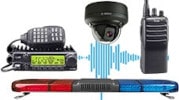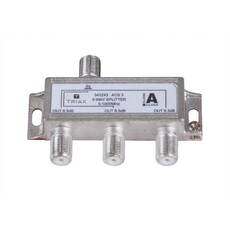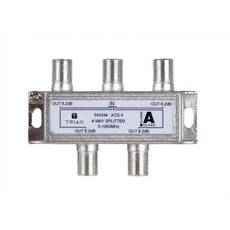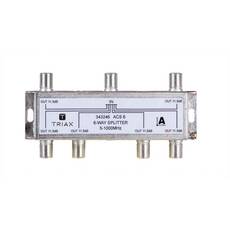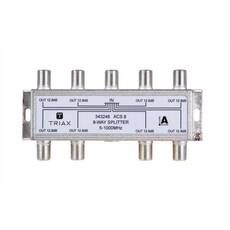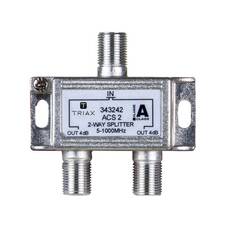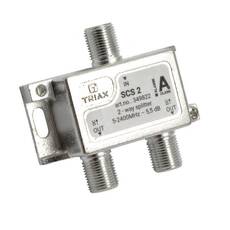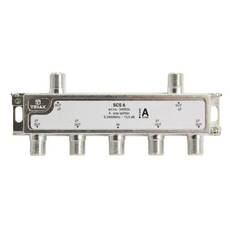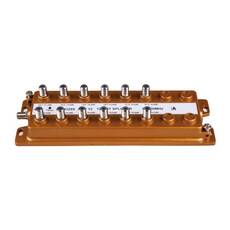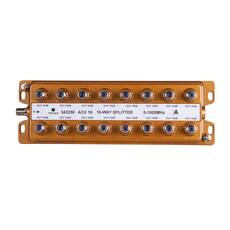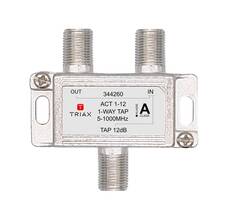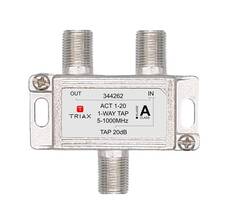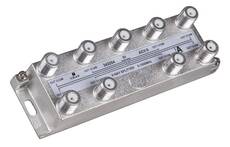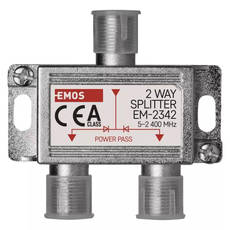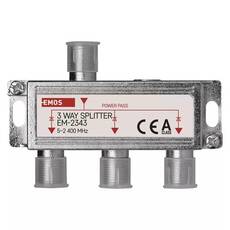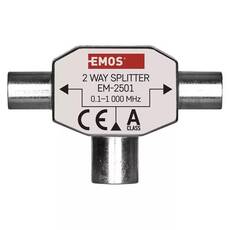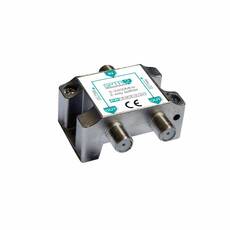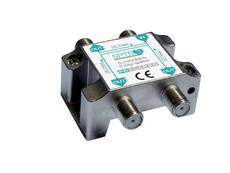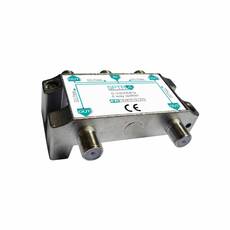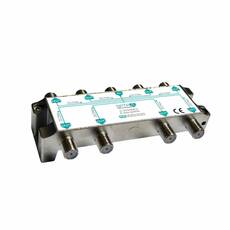TV Antenna Splitter
Almost everyone has faced the situation where they wanted to split the TV signal between multiple endpoints in their home. Cable TV providers are required to provide a signal strength that can be shared between 2-3 endpoints without any problems. However, if you want to distribute the cable TV signal to more than one endpoint, you will need to install one or more antenna splitters and sometimes a cable TV amplifier. In a home with TVs in several rooms, or in a large house with TVs far apart, this is almost a common situation. Read more...
• The full range of TRIAX distribution performance for CATV, SMATV and MATV
• Frequency range: 5-1000 MHz
• Number of outputs: 3
• Impedance: 75 Ω
• Shielding efficiency VHF/UHF: > 110 dB
• High-quality die-cast housing with Sn coating
• All AC/DC ports are blocked at the inner conductor
• Dimensions: 54 mm (height) x 74 mm (length) x 15 mm (depth)
• Broadband splitter for cable TV or terrestrial antenna signal distribution
• Does not pass DC power
• The full range of TRIAX distribution performance for CATV, SMATV and MATV
• Frequency range 5-1000 MHz
• Number of outputs 4
• Impedance 75 Ω
• Shielding efficiency VHF/UHF > 110 dB
• High quality die-cast housing with Sn coating
• All AC/DC ports are blocked at the inner conductor
• Dimensions: 54 mm (height) x 74 mm (length) x 15 mm (depth)
• Broadband splitter for cable TV or terrestrial antenna signal distribution
• Does not pass DC power
• The full range of TRIAX distribution performance for CATV, SMATV and MATV
• Frequency range: 5-1000 MHz
• Number of outputs: 6
• Impedance: 75 Ω
• Shielding efficiency VHF/UHF: > 110 dB
• High-quality die-cast housing with Sn coating
• All AC/DC ports are blocked at the inner conductor
• Dimensions: 60 mm (height) x 120 mm (length) x 15 mm (depth)
• Broadband splitter for cable TV or terrestrial antenna signal distribution
• Does not pass DC power
• The full range of TRIAX distribution performance for CATV, SMATV and MATV
• Frequency range: 5-1000 MHz
• Number of outputs: 8
• Impedance: 75 Ω
• Shielding efficiency VHF/UHF: > 110 dB
• High quality die-cast housing with Sn coating
• All AC/DC ports are blocked at the inner conductor
• Dimensions: 60 mm (height) x 140 mm (length) x 15 mm (depth)
• Broadband splitter for cable TV or terrestrial antenna signal distribution
• Does not pass DC power
• TRIAX indoor distribution full power for CATV, SMATV and MATV
• Frequency range: 5-1000 MHz
• Number of outputs: 2
• Impedance: 75 Ω
• Shielding efficiency VHF/UHF: > 110 dB
• High-quality die-cast housing with Sn coating
• All AC/DC ports are blocked at the inner conductor
• Dimensions: 54 mm (height) x 52 mm (length) x 15 mm (depth)
• Broadband splitter for cable TV or terrestrial antenna signal distribution
• Does not pass DC power
• TRIAX coaxial splitter ideal for SAT-IF and MATV distribution networks
• Frequency range: 5-2400 MHz
• Impedance: 75 Ω
• Number of inputs: 1
• Number of outputs: 2
• Connector type: socket F (IEC 61 169-24)
• DC pass diodes on all outputs
• Shielding efficiency VHF/UHF: >85 dB
• High shielding against input noise emitted by LTE mobile
• High-quality cast housing with tin (Sn) solder shield bottom plate
• Dimensions: 47 mm (height) x 52 mm (width) x 17 mm (depth)
• Broadband splitter for cable TV, satellite or terrestrial antenna signal distribution.
• Passes DC power
• TRIAX coaxial splitter ideal for SAT-IF and MATV distribution networks
• Frequency range: 5-2400 MHz
• Impedance: 75 Ω
• Number of inputs: 1
• Number of outputs: 6
• Connector type: female F (IEC 61 169-24)
• DC pass diodes on all outputs
• Shielding efficiency VHF/UHF: >85 dB
• High shielding against input noise emitted by LTE mobile
• High-quality cast housing with tin (Sn) solder shield bottom plate
• Dimensions: 47 mm (height) x 118 mm (width) x 17 mm (depth)
• Broadband splitter for cable TV, satellite or terrestrial antenna signal distribution.
• Passes DC power
• The full range of TRIAX distribution performance for CATV, SMATV and MATV
• DVB-C (cable) or DVB-T2 (digital terrestrial) signal splitting
• Frequency range: 5-1000 MHz
• Number of outputs: 12
• Impedance: 75 Ω
• Shielding efficiency VHF/UHF: > 110 dB
• High quality die-cast housing with Sn coating
• All AC/DC ports are blocked at the inner conductor
• Broadband splitter for cable TV or terrestrial antenna signal distribution
• Does not pass DC power
• The full range of TRIAX distribution performance for CATV, SMATV and MATV
• DVB-C (cable) or DVB-T2 (digital terrestrial) signal splitting
• Frequency range: 5-1000 MHz
• Number of outputs: 16
• Impedance: 75 Ω
• Shielding efficiency VHF/UHF: > 110 dB
• High quality die-cast housing with Sn coating
• All AC/DC ports are blocked at the inner conductor
• Broadband splitter for cable TV or terrestrial antenna signal distribution
• Does not pass DC power
• Asymmetric distribution splitter
• Manufacturer number: 344260
• Frequency range from 5 MHz to 1.0 GHz
• Number of outputs: 2
• All ports AC/DC blocked at inner conductor
• 110 dB shielding effectiveness and Grade 2 return loss (>18 dB)
• Tap loss: 12 dB
• Dimensions: 52 x 46.5 x 16.2 mm
• Asymmetric distribution splitter
• Manufacturer number: 344261
• Frequency range from 5 MHz to 1.0 GHz
• Number of outputs: 2
• All ports AC/DC blocked at inner conductor
• 110 dB shielding effectiveness and Grade 2 return loss (>18 dB)
• Tap loss: 16 dB
• Dimensions: 52 x 46.5 x 16.2 mm
• Asymmetric distribution splitter
• Manufacturer number: 344262
• Frequency range from 5 MHz to 1.0 GHz
• Number of outputs: 2
• All ports AC/DC blocked at inner conductor
• 110 dB shielding effectiveness and Grade 2 return loss (>18 dB)
• Tap loss: 20 dB
• Dimensions: 52 x 46.5 x 16.2 mm
• Broadband distribution cable TV or terrestrial antenna signal distribution
• Manufacturer number: 344254
• Frequency range from 5 MHz to 1.0 GHz
• Number of outputs: 8
• Impedance: 75 ohm
• All ports AC/DC blocked at inner conductor
• 110 dB shielding effectiveness and Grade 2 return loss (>18 dB)
• Connector type: F socket
• Dimensions: 115 x 35 x 17 mm
• Input: 1
• Outputs: 2
• Connector type: F
• Attenuation: 3,7 dB
• Frequency range: 5–2400 MHz
• Broadband splitter for cable TV, satellite or terrestrial antenna signal distribution.
• Passes DC power
• Number of inputs 1; number of outputs 3
• Connector type: F
• Input attenuation: 6 dB
• Frequency range: 5-2 400 MHz
• Type: ferrites
• Direct (DC) voltage (power pass)
• Use: TV + R + SAT
• Antenna distribution material: zinc die-cast
• Dimensions: 20 × 56 × 25 mm
• IP20 protection
• Number of inputs 1; number of outputs 4
• Connector type: F
• Input attenuation: 7,5 dB
• Frequency range: 5-2 400 MHz
• Type: ferrites
• Direct (DC) voltage (power pass) yes, 4×
• Use: TV + R + SAT
• Antenna distribution material: zinc die-cast
• Dimensions: 20 × 56 × 25 mm
• Protection class: IP20
• Number of inputs 1; number of outputs 2
• Connector type: IEC
• Input attenuation: 3,5 dB
• Frequency range: 0,1-1 000 MHz
• Type: ferrites
• Direct (DC) voltage (power pass)
• Use: TV + R
• Antenna distribution material: zinc die-cast
• IP20 protection
• Dimensions: 17 × 32 × 23 mm
• 2-output “top-down” horizontal splitter with F connector for TV and Satellite band
• Frequency: 5-2400MHz
• Impedence: 75 Ω
• Outputs: 2
• Connector: F female
• Passes DC power
• Dimensions: 58mm x 52mm x 25mm
• Weight: 0,074 kg
• 3-output “top-down” horizontal splitter with F connector for TV and Satellite band
• Frequency: 5-2400MHz
• Impedence: 75 Ω
• Outputs: 3
• Connector: F female
• Passes DC power
• Dimensions: 58mm x 52mm x 25mm
• Weight: 0,078 kg
• 4-output “top-down” horizontal splitter with F connector for TV and Satellite band
• Frequency: 5-2400MHz
• Impedence: 75 Ω
• Outputs: 4
• Connector: F female
• Passes DC power
• Dimensions: 77 mm x 58 mm x 25 mm
• Weight: 0,098 kg
• 6-output “top-down” horizontal splitter with F connector for TV and Satellite band
• Frequency: 5-2400MHz
• Impedence: 75 Ω
• Outputs: 6
• Connector: F female
• Passes DC power
• Dimensions: 120 mm x 60 mm x 22 mm
• Weight: 0,132 kg
• 6-output “top-down” horizontal splitter with F connector for TV and Satellite band
• Frequency: 5-2400MHz
• Impedence: 75 Ω
• Outputs: 6
• Connector: F female
• Passes DC power
• Dimensions: 120 mm x 60 mm x 22 mm
• Weight: 0,136 kg
Using the TV antenna splitter
Dividing the incoming TV signal is a very simple process, but you do need to be careful about the type of broadcasting you are using. It makes a difference whether you want to share a digital terrestrial signal (DVB-T/T2) or a satellite signal (DVB-S/S2). For digital terrestrial signals, a simple two-way antenna splitter can solve the problem. It's worth knowing that the more outputs an antenna splitter has, the higher its attenuation, i.e. the more of the signal it attenuates. Whether or not you actually have a TV set connected. If you have a TV aerial that is suitable for your home, it should have enough gain to distribute the signal to two endpoints without any problems, but more sharing can lead to a degradation of the picture.
And if the reception is not perfect at the moment, any splitting will only further degrade the signal quality. Cable TV incoming signals are required to be between 60 and 70 dBV. This means 10 dB attenuation with a good quality splitter. So after the signal is split, it will be somewhere between 50 and 60 dBV, which can cause a grainy picture on many TVs.
How to choose the right TV antenna splitter?
If the use of a TV aerial splitter is unavoidable and it is the only option for connecting another television, it should be chosen with great care and according to its characteristics. In addition, proper signal transmission is also important. This means that a cable TV antenna splitter is not suitable for transmitting satellite dishes or analogue TV signals. When choosing the right TV antenna splitter, make sure to use only and only a good quality splitter, cable or connector.
These devices are responsible for the quality of the transmission and affect not only the picture itself, but also the speed of the picture and sound transmission. Poorer quality TV aerial splitters are not able to transmit the signal at the same speed, so the consequence can be distracting when watching TV. The type of splitter you choose also depends on what you want to use it for. For a simple hub, the number of outputs can vary from 2 to 8, but too many outputs can cause signal loss. If you want to connect more TVs to the antenna, you will need a TV antenna combiner.
What connection options are available?
Modern televisions have a wide range of connectors. To find out exactly which devices and cables you can connect to your TV, take a look at the sockets on the back or side of your TV. In the past, most TV connections were made using power sockets that accept IEC plugs, but nowadays we use F-type sockets.
This is an RF-type connector used for connecting RG-6 type coaxial cables in cable, satellite and terrestrial television. These are modern versions of coaxial cables that, unlike normal aerial cables, have an F-connector at each end. There are also multimedia antenna connectors, which can be used to connect cable TV, satellite dishes and terrestrial receivers, i.e. R/TV.
How to install and configure a TV antenna splitter?
For this easy operation, you will need a blancher and a clamp. You should start the workflow with the blanching pliers. We need to cut the cable end to size. Next, we fold back the shielding braid, strip the insulation and then use the clipping pliers to attach the appropriate connector to each end of the cable. Then all that remains is to insert the right end of the cable into the distributor and the other end into the socket.
When is a TV aerial splitter not enough?
With digital terrestrial signal, if you want to distribute the received TV signal to more than two endpoints, you will need an antenna amplifier to ensure that reception is adequate at each endpoint. In this case, you should buy a splitter of the size you actually need. If you buy a much bigger one, you will unnecessarily over-attenuate the incoming signal.
Also, it is not worth splitting the satellite signal in the traditional way with an antenna splitter, as the cable coming out of the head cannot be split in this case. If you want to use multiple satellite receivers, you need multiple heads, each of which functions as a separate satellite head. If you just distribute them, the indoor satellite receivers connected to them may give different commands to the head, which will then certainly not work properly.
The 2 way Emos antenna splitter from DND is the perfect choice for most TV signal sharing situations. With two outputs and 3.7 dB of attenuation, it allows you to split the signal from the antenna into two separate TV sets without any problems. All without causing signal loss or grainy picture.

